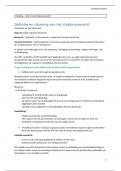Summary
Summary GCSE Biology NOTES
GCSE Biology condensed notes for all topics. Targetted at AQA but can be used for other exam boards. Concise and precise notes for effective revision. Includes mindmaps, diagrams and summaries. Topics include: 1) Cell biology 2) Cell division 3) Enzymes 4) Organising animals 5) Organising p...
[Show more]





